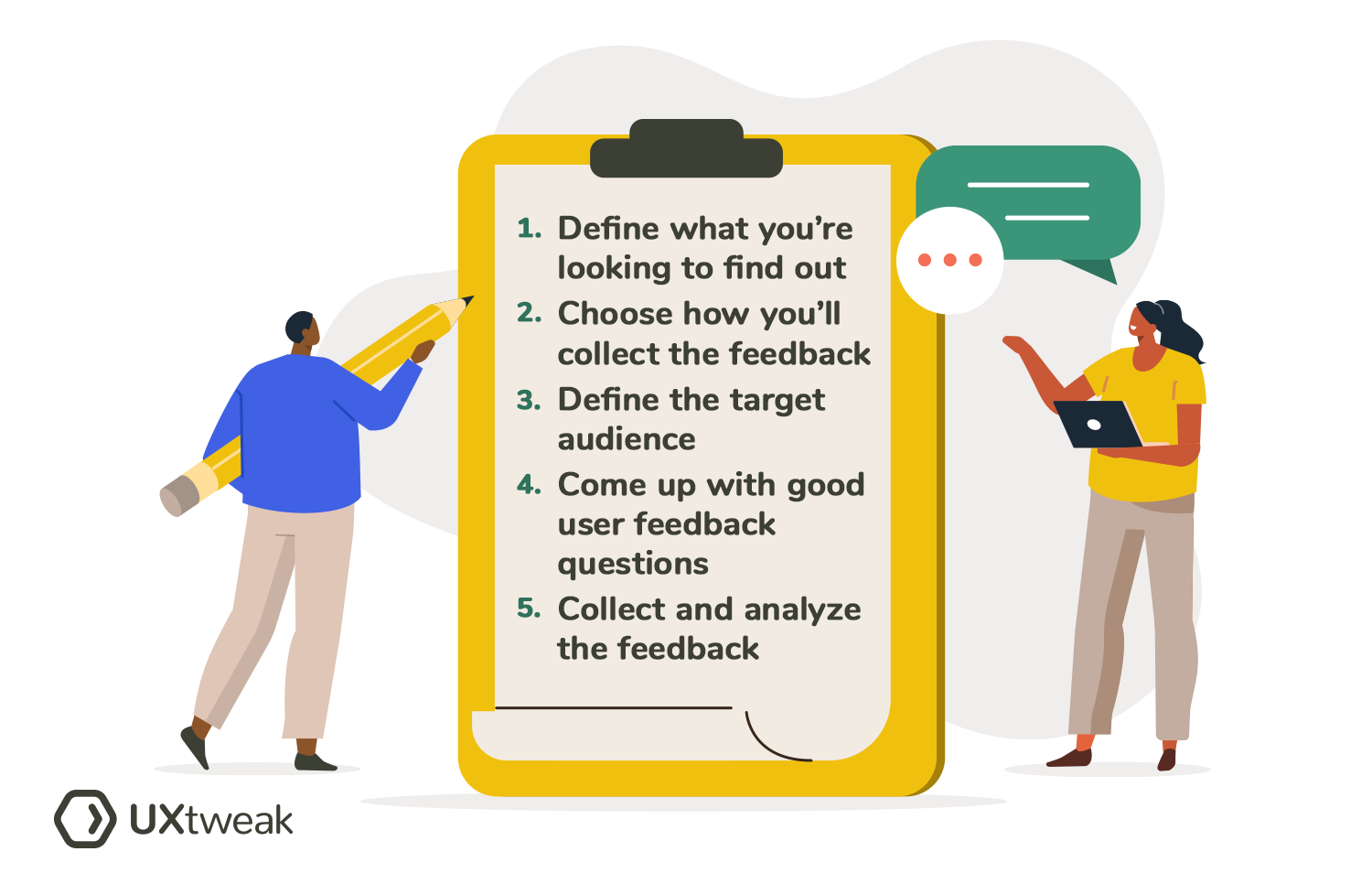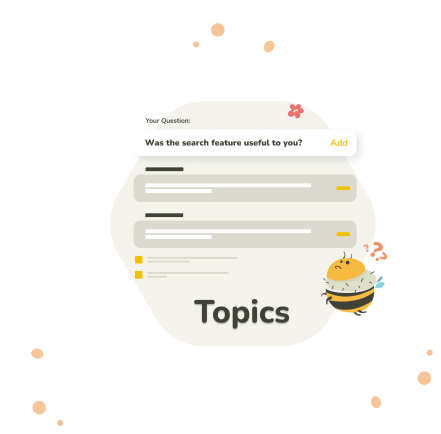User feedback is the drive that leads companies and their products towards constant improvement. It keeps us user-centered at all times and helps to understand the needs, wants, expectations and pain points of our target audience.
But why is it so important and how to collect it? Let’s find out⬇️
What is user feedback?
User feedback is all the information about your customers’ opinions on your product, what they like, dislike, don’t understand or would like to be improved. Consistently gathering user feedback is essential to inform the UX design process and ensure product’s success in the future.
The process of collecting user feedback is focused on gathering quantitative and qualitative data from your users, using various user feedback tools and collection methods. The goal of such process is to gather enough information to support design decisions and make product adjustments so that it corresponds to user’s expectations and provides them with exceptional user experience.
Why user feedback is important?

When we are creating a new product or updating an existing one, it’s easy to get blinded by our own perception of what it needs to look and feel like, without taking users’ needs into consideration. Taking time to gather user feedback at different stages of the design process helps to ensure you’re on the right track and are creating a helpful user-centered product.
Consistently listening to your users and making the most out of their feedback can help to fine-tune the product to fit their needs and gain competitive advantage in the industry. This also helps to keep your users engaged, show that their opinion matters and that their needs are your main priority.
Overall, collecting user feedback can help to:
- Inform design decisions: user feedback shows what works and what doesn’t in your designs, and helps to make decisions about adding or removing certain features and design elements to make the product better.
- Understand users: by asking quotations and analyzing their responses you’re able to get a unique perspective on who your users are, what matters to thema and what you can do to satisfy their needs.
- Improve the quality of your product: user feedback helps to point out bugs, usability issues and any other points of confusion in your product. By identifying them, teams are then able to come up with ways to solve those issues, improving the overall quality of the product.
When do you need user feedback?

While user feedback is crucial and valuable at all times, there are specific stages of the design process when it’s recommended to collect it in order to ensure that your future product meets customer’s needs.
At the beginning of the design process
At the beginning of the design process you don’t yet have a product to test with, however, it doesn’t mean that you can skip the process of user feedback collection. While you don’t have a product itself, you probably already have an idea of where it will stand in the market and what its primary goals will be.
Therefore, at this stage you should be conducting concept tests to validate your ideas and focus on user research to get to know your future customers better. These are all the ways of gathering user feedback that will later help to inform design decisions and create user-centered product prototypes.
Research methods that are helpful at this stage are user interviews, surveys and concept tests.
During the prototyping stage
Gathering user feedback throughout the prototyping stage will help to pinpoint usability issues early and fix them as you go. At this stage you already have a design to test with so you can gather user feedback through prototype testing, preference testing, 5-second tests and first click tests.
Conducting several rounds of usability tests at this stage of the design process will show how users interact with your designs, what makes them confused or frustrated, where they get lost etc. These tests can also help to bring unexpected insights about what you can add to the design to make it more intuitive user-oriented. Or, vice versa, show that a certain feature or design element is useless and needs to be eliminated.
On-going
As time flies, your user changes and so do their needs, pain points and expectations from your product. Gathering user feedback should be an iterative process.
So to ensure your product is always up-to-date make regular preventive checks in the form of usability tests and gather user feedback through customer satisfaction surveys. This way, even though your product will change and become more complex over time, you’ll always be able to maintain user-friendliness and good UX.
Before redesign or introduction of the new feature
In this case scenario you have a product you want to either redesign or add a new high-priority feature to. You might think that you already know your users and their needs so why collect additional user feedback?
However, in order to make sure you don’t waste your time and money on creating something that doesn’t solve current user pain points we recommend to always start this process with user research. Find out what users don’t like or lack in the current design and how you can do your best to upgrade it.
Test throughout the whole process and conduct a usability test in the end to ensure that whatever new feature or design element you’ve implemented works as intended.
How to gather user feedback?

Collecting and analyzing user feedback can be a breeze when done right. All you have to do is follow a structured process in order to not get overwhelmed by the amounts of information you’re probably going to gather.
We recommend sticking to this 5-step process:
- Define what you’re looking to find out
- Choose how you’ll collect the feedback
- Define the target audience
- Come up with good user feedback questions
- Collect and analyze the feedback
Let’s take a closer look at each of the steps.
1. Define what you’re looking to find out
Start by formulating clear goals of your research process. What do you want to find out from your users? What is the product, feature, design element you’re going to be gathering feedback on?
You may want to evaluate the effectiveness of a new feature, the quality of your customer support or gather user’s opinion on your product’s new redesign. Whatever it is, make sure to define the goal clearly so that you can stay focused on it the whole time and not get distracted by some other minor fixes that need to be done.
Additionally, defining a clear goal for your research will help to come up with a good list of topic-specific questions and gather deep meaningful insights.
2. Choose how you’ll collect the feedback
There are various ways to capture user feedback and choosing the one that suits your specific use case is the key part of the process. Some of the most common methods of collecting user feedback include surveys, interviews, focus groups, usability tests and others.
In more complex cases, you may want to choose multiple research methods to collect information. This approach would definitely help to get a deeper understanding of user’s opinions and perspectives as it allows to gather both qualitative and quantitative insights. However, this could also be achieved by using one method only, for example, UX surveys with open-ended and closed types of questions mixed together.
Choose your methods wisely based on the goals of the study as well as the budget and time available.
3. Define the target audience
The next step is to choose the target audience for your research. It’s crucial to gather feedback from the people who are representative of your end-users. These could be your current or potential customers, people who represent a certain segment of your target audience, or those who’ve recently interacted with your product or used a certain service.
An easiest way to get quick feedback from your audience is by turning website visitors into study participants with Onsite Recruiting widget. This way you don’t even have to send out a feedback survey and can just ask for their opinion while they’re interacting with your product or a certain feature. Don’t forget to provide incentives in the form of discount codes and coupons in exchange for their initiative.
For some other research methods you may need to recruit participants for a longer and more complex study. Online user feedback tools often provide a respondent pool where you can get those testers. Whatever your target audience is, take your time to analyze its profile and specify the requirements for respondents that you’re going to recruit.
With UXtweak you can recruit study participants from a 155M+ User Panel with over 2000+ profile attributes from all over the world. It doesn’t get any more specific than that!😉 If you want to learn more about UXtweak User Panel, don’t miss out on our video:
4. Come up with user feedback questions
With the goals of your study in mind, brainstorm a list of questions that could help in achieving them.
Make sure that you have both open-ended and closed questions in your list, to gather different perspectives on your users’ opinions. Closed questions will provide you with numerical insights and statistical data that can be easily measured with the help of metrics we described above. Open-ended questions, on the other hand, will give you a better look at the reasons behind those statistics and allow users to share their thoughts.
Try to remain unbiased when writing the questions and avoid using wording that could lead the participants towards a certain response.
Learn more about writing user feedback questions [with question examples].
5. Collect and analyze the feedback
After you conduct the study it’s time to analyze the results and make sense of all the user feedback you gathered. The good news is, most of the numerical data will be analyzed for you by the user feedback tool of your choice.
However, after the study you’ll also have piles of qualitative data on your hands and making sense of it all can be frustrating. We recommend to use the following tips:
- Organize the feedback – gather all of the feedback in one place and try to organize it into similar categories, based on common themes. These could be: usability, design, feature requests etc. The themes may be a lot more specific and should be based on the initial goals of your study.
- Look for common patterns – identifying patterns will help to pinpoint most common issues among users and show where you should prioritize making improvements.
- Prioritize the issues – not all of the problems are equally important to solve. Prioritizing issues in their severity (high, low and medium) will help to stay focused on the most crucial fixes.
Best practices for collecting and analyzing user feedback

Here’s a quick overview of the best practices and tips you can follow to make your user feedback collection process a breeze:
- Remain unbiased – mainly when writing your user feedback questions, make sure that they don’t lead respondents towards a certain response or influence their answers in any way.
- Pilot your studies before the launch – this best practice applies to almost all cases, no matter the research method. Pilot your study with a friend or colleague to ensure everything works as intended and no confusions arise.
- Don’t forget personalization – with those user feedback collection methods, where there’s room for personalization, make sure to make use of it. This could be a customer feedback survey, for example. You’re already reaching out to them for a certain reason, and you know who they are, why not add a personalized message to a survey to increase completion rates?
- Gather both qualitative and quantitative data – to get a versatile perspective on what your users thing you’ll need both numerical and qualitative insights
- Use mixed method research – following up on the previous tip, in order to gather both types of data you may need to use more than one research method in the data collection process
- Collect feedback consistently – it’s important to collect user feedback iteratively, throughout the whole design and development process. This will help you remain user-centered at all times, as well as quickly spot and fix serious issues.


